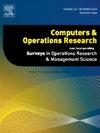托盘装载问题的多重最优解与模式
IF 4.3
2区 工程技术
Q2 COMPUTER SCIENCE, INTERDISCIPLINARY APPLICATIONS
引用次数: 0
摘要
托盘装载问题是制造、运输和物流领域中常见的优化问题。它包括把尽可能多的相同的矩形盒子放在一个矩形托盘上。随着解决这一问题的方法不断发展并得到广泛采用,为各种托盘装载场景找到多个最佳解决方案已经变得很常见。然而,这一现象在文学中仍未得到充分探讨。本研究确定并分析了托盘装载问题的多个最优解决方案的特征,提供了对其模式,转换和实际应用的见解,从而弥合了当前文献中的差距。通过分析与已识别的模式特征相关的结果,我们提供了大量实例、解决方案和实际示例。我们还确定了实现单一最佳模式和完美模式的条件,同时探索了完美分区、完美轮廓和完美模式的概念和应用。本研究旨在提高对问题的解决方案和装载模式的理解,最终促进为现实世界的物流应用生成和实施完美或近乎完美的托盘装载模式。本文章由计算机程序翻译,如有差异,请以英文原文为准。
On the multiple optimal solutions and patterns of the pallet loading problem
The Pallet Loading Problem is a common optimization issue in the fields of manufacturing, transportation, and logistics. It involves placing as many identical rectangular boxes as possible onto a rectangular pallet. As methods for solving this problem continue to advance and gain widespread adoption, it has become common to find multiple optimal solutions for various pallet-loading scenarios. However, this phenomenon remains underexplored in literature. This study identifies and analyzes the characteristics of multiple optimal solutions for the Pallet Loading Problem, offering insights into their patterns, transformations, and practical applications, thus bridging the gap in the current literature. We present a substantial number of instances, solutions, and practical examples by analyzing the results in relation to the identified pattern features. We also identify the conditions for achieving single optimal patterns and perfect patterns while exploring the concepts and applications of perfect partitions, perfect contours, and perfect patterns. This study aimed to enhance the understanding of the solutions and loading patterns of the problem, ultimately facilitating the generation and implementation of perfect or near-perfect pallet loading patterns for real-world logistics applications.
求助全文
通过发布文献求助,成功后即可免费获取论文全文。
去求助
来源期刊

Computers & Operations Research
工程技术-工程:工业
CiteScore
8.60
自引率
8.70%
发文量
292
审稿时长
8.5 months
期刊介绍:
Operations research and computers meet in a large number of scientific fields, many of which are of vital current concern to our troubled society. These include, among others, ecology, transportation, safety, reliability, urban planning, economics, inventory control, investment strategy and logistics (including reverse logistics). Computers & Operations Research provides an international forum for the application of computers and operations research techniques to problems in these and related fields.
 求助内容:
求助内容: 应助结果提醒方式:
应助结果提醒方式:


